Fence, created by C.S. Pacat and Johanna the Mad, follows the story of sixteen year old Nicholas Cox as he enters into the world of competitive fencing. I had the opportunity to interview C.S. Pacat, Johanna the Mad, as well as Fence: Striking Distance author Sarah Rees Brennan which you can read below.
In your own words, how did the genesis of Fence come to be? How would each of you describe your own path to becoming involved in Fence?
Sarah Rees Brennan: I came in at a later date than the others! I was a fan first: I love C.S. Pacat’s writing so I read the Fence graphic novels and was delighted by all the ingredients (the setting of a fencing team at an elite boarding school, the boy from the wrong side of the tracks versus the Olympic hopeful), and thus naturally became a fan of Johanna’s fabulous artwork. My lovely editor at Little Brown reached out to my agent and expressed interest in me writing a tie-in novel. My first reaction was ‘that’s so great, they must be doing really well! They deserve it.’ I’m always so delighted when wonderful LGBT stories find the audience they deserve. Then I went ‘Wait… me?’
C.S. Pacat: I got really into sports comics in Japan, where I lived for about five years. I love the striving and intense rivalries, the friendships and found families, the way you can take characters to their breaking point. I fenced épée all through high school, and thought it was the perfect sport for that kind of comic: it’s intensely strategic and psychological, a solo combat sport with a rich history. Fencing is also a sport famous for its striking visuals, its silhouettes, and its arresting lines. I had started to see the first queer sports stories begin to appear, like Ngozi Ukazu’s fantastic LGBT hockey comic Check, Please! and the joyously queer-coded Japanese anime Yuri!!! on Ice. I started to wonder, what happens when all these energies come out in a combat sport?
Johanna the Mad: At the time, I had recently read C. S. Pacat’s Captive Prince trilogy and instantly became a huge fan of her writing. Parallel to this, I was also really into sports anime and manga so when I was offered to be part of Fence it was like a dream come true.
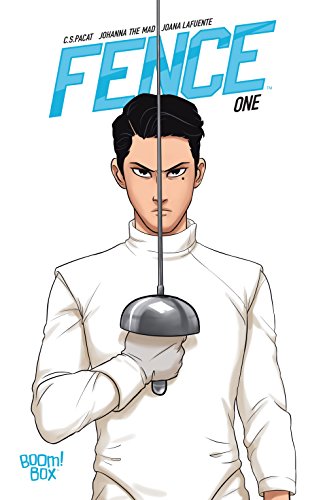
As a queer person, would you say you incorporated some of your own experiences into the queer media you create?
CSP: I know that for me, as a queer kid growing up, there were so few queer characters that I remember how I clung to each one, rereading the tiny handful books or manga I could find with queer protagonists over and over again. It was the era where queer stories usually had sad endings, and it made me want to write stories of joyful and exuberant queerness. That’s where my decision to write prejudice free, homo-normative worlds came from. I developed this approach to art where I thought: if the purpose of the art is realism, then of course it’s important to show real-wold prejudices, but if the purpose of the art is escapism, then I want everyone to be able to escape equally.
I write a lot of “found families”, because I grew up in a time where being able to be openly queer meant having to step outside the mainstream, and “find” others like you, with whom you could be yourself. More prosaically, I’m bi, and all my main protagonists end up being bi, and in fact I have to make a Herculean effort not to instinctively write every character as bi. Bobby is probably the closest that I’ve come to writing a character that expresses my gender(queer) identity, at least as I understood it back when I was in high school.
JM: Sure. My work is mostly based on displaying emotions which, the majority of the time, are romantic. There’s something about romance that I enjoy illustrating so I guess it’s a given I’d translate my vision and experiences into what I want to draw.
Prior to this book, you had already written critically acclaimed stories, including the Lynburn Legacy series. How did you get signed on to writing a novel for Fence? What was the process like writing a story with an already established world and characters? What did it feel like trying to stay faithful to the feel of the original material while providing your own spin?
SRB: I have written quite a few books! And it’s been so great to see the publishing landscape changing to be more inclusive over that time. I’m also a longtime fan of C.S. Pacat’s work. I loved her Captive Prince series, so when I went to live in Australia for six months several years back, I reached out and was like ‘Hey, be my friend.’ (I make friends like a pleasant, garrulous hostage taker.) Thus followed many writing dates in which I continually ate ice-cream while we yelled at each other about narrative tropes, and an adventure on a pirate ship on the Yarra river surrounded by black swans.
As a writer, she’s extremely generous with her time and her story insights. C.S. Pacat has this amazing internal compass for story, a sense for finding the truest path, so when the opportunity offered I knew it would be fun to work with her, and that when we talked through story paths I could trust her to guide me right.
I’ve written work in previously established universes before, most recently for tie-in novels in the universe of Netflix’s The Chilling Adventures of Sabrina. A graphic novel is like a TV show in that they’re both visual mediums. I love storytelling in all its forms, so it’s an exciting challenge to think, how could this form work to tell this story? What light can this particular medium shed on this universe? A book has less surface than any other form of entertainment. Books can go into the deep waters, can offer introspection, so you know more of the characters’ pasts and feelings, and that knowledge can illuminate the action in all forms of the story. So to me, writing books in previously established worlds feels like going into the story spaces with a light.
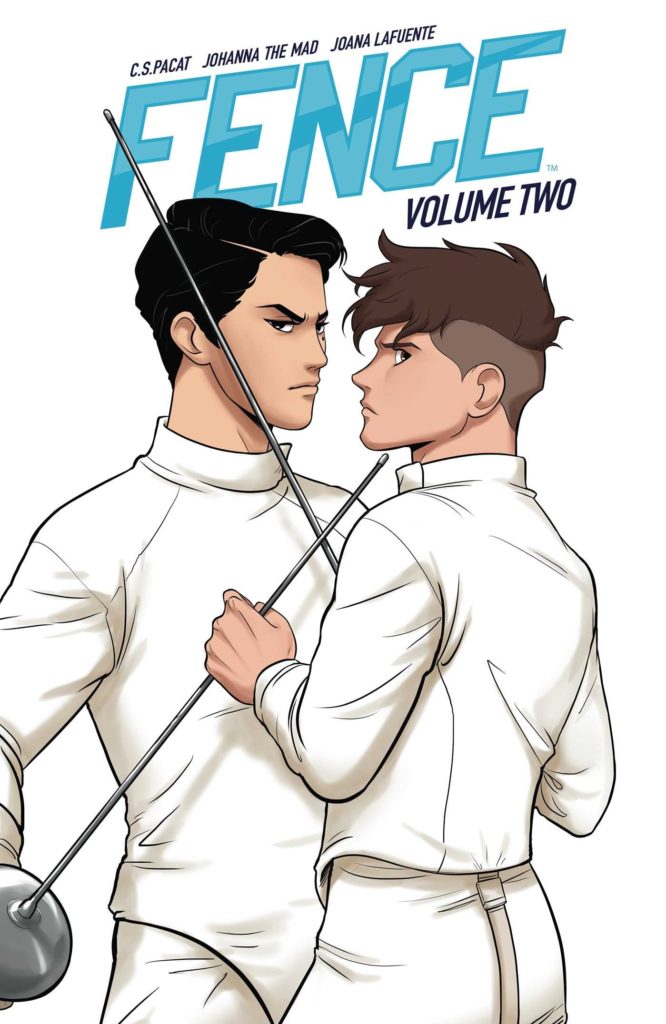
In previous articles, part of the stated inspiration for Fence came from sports-related anime and manga, such as Haikyuu, as well as American comics like Check Please! What would you say are some of your other favorite examples from the genre?
SRB: Hikaru no Go! I loved learning about the game of Go, and the fantastical premise of the ghost pushing a boy to learn a game which he doesn’t care much about… until he meets and becomes fascinated by a prodigy at the game. I love intensity of a rivalry, which has all the joy of enemy interactions but none of the moral dilemmas. You still really really want to beat them, but you don’t usually kill them at the end! (Sometimes you do. Sometimes rivalry goes wrong.) The characters’ connection to, and pride in, their skill at the game of Go/tennis/the magic ninja path/fencing leads them to connect to each other whether in hatred or love, or a mix of the two. And then the connection works in a feedback loop, so the more you care about your rival the more invested you are in the sport, and more the audience cares about the characters, the more invested they are in the outcome of the game.
CSP: My favourite sports manga is Hikaru no Go. It was one of the first sports manga I read that took its sport completely seriously. No one turned into a demon on the field, no one did a supernatural “finishing move”, it was just a young boy playing Go, often in smoke filled rooms with old geezers. Counter-intuitively, that made the sport itself seem more intense and thrilling.
I’d also want to shout out to my all-time favourite anime Utena. Although it’s not a sports anime, it was a huge influence on Fence. Each episode features the characters duelling in an arena swordfight, in a fantastical queer reimagining of the classic shounen level-up structure.
JM: My all-time favorites would be Slam Dunk, Eyeshield 21 and Kuroko no Basket. A special mention would be Yuri on Ice since I love how they managed both the sports theme along with the protagonists’ queer relationship.
While all the characters of Fence are all incredibly lovable, are there any characters you have a preference writing about/ drawing?
SRB: I agree all the characters are lovable, which I can say without shame as I didn’t create them. Seiji was my favourite character to write, actually! I love them all, but there’s a particularly fun challenge in writing the guy for whom so much is internal. There’s a certain archetype of a character who’s a stickler for the rules, and doesn’t evince many emotions, but who clearly has so much going on under a seemingly cold surface. I love the frozen lake with lava beneath sort: the repressed emotion is always going to manifest in interesting ways.
I just started watching, on the recommendations of many people, a Chinese drama called The Untamed, and I spotted a disgruntled elven-appearing gentleman, and was like ‘Ah, here we have that guy again. Love that guy.’ I do think, however, that character is much easier to convey in a visual medium. An actor can give you microexpressions to let you know where they’re at, or Johanna can give us clues through her fabulous art! So I read the graphic novels and read about this fencing prodigy whose life is about his skill, and went, ‘I love Seiji,’ and then thought ‘oh no… I have to write Seiji from inside his head!’ Nobody’s distant, emotionless or formidable in their own mind, and the drive to excel comes from deep caring. Writing Seiji required a lot of thought about how he saw the world, versus how he saw himself. Seiji and his parents have trouble connecting—Seiji and the world have trouble connecting—and the challenge of connecting to him made me love him.
CSP: Don’t ask me to choose!
JM: Yes! My favorites are Bobby, Harvard and Nicholas. Can’t have enough of those three. I get so excited whenever they’re in a panel together, it’s ridiculous.
One of my personal favorites from the series, Seiji Katayama, seems to display a number of attributes that could be coded as being on the autistic spectrum, i.e. trouble reading social cues, hyper-focus on specific subjects, etc. Are there any characters from the series that could be said to be neurodiverse?
CSP: One character that will be explicitly neurodiverse is Assistant Coach Lewis. I don’t want to spoil anything from upcoming storylines, but I’m looking forward to her having her moment to shine later in the series.
One of the key defining elements of the series is the intense dynamic between Seiji Katayama and Nicholas Cox. Could you elaborate on their relationship, and the very slow-burn element of their story?
SRB: It is a slow burn, isn’t it! I love that, I hate when a relationship feels rushed. In the words of Oscar Wilde, ‘the suspense is terrible… I hope it will last.’ Seiji has a profound effect on Nicholas from their first fencing match, in which Seiji’s skill and dismissal of Nicholas spark fresh determination in Nicholas, and when they continue as roommates in a school where neither of them ever really thought they would be, Nicholas begins to have an effect back—not just Nicholas’s promise in fencing, but irrepressible Nicholas starts talking about being friends. It’s unstoppable force vs immovable object, so every step has to be earned. In Striking Distance we see Seiji making a concession to Nicholas, and C.S. Pacat and I had several discussions about how much of a concession it might be. It had to be tiny. The progress is incremental, but it is there. The suspense is terrible… and I do hope it will last.
CSP: I’m fascinated by the dynamic of “natural rookie” versus “highly trained pro”, which is a classic staple of sports stories. But I never really liked the way that the rookie always wins out in Western sports stories, either triumphantly beating the pro (like Rocky beating Ivan in Rocky IV) or with a moral victory when the pro realises they live a life of empty of feeling and quits their sport (like Maureen quitting ballet in Center Stage). It just seemed so unfair to the pro who had put in so much more work, dedicating their whole life to their sport! I much prefer the way these archetypes are handled in Japanese sports comics, where the rookie and the pro each have something to learn from the other (like Hikaru and Akira from Hikaru no Go, or Nodame and Chiaki in Nodame Cantabile). I loved the idea of using these opposites as the basis for an intense and developing relationship, where each character completes something in the other.
As for the slow-burn, I always think—well, difficult accomplishments are the best because you have to work to achieve them.
Without any spoilers, how does Striking Distance fit into the timeline of the Fence comic universe? Will any references from the novel make its way into future comics?
CSP: Striking Distance is set right after Fence Rivals, the newly-released fourth volume graphic novel. Sarah Rees Brennan has a genius for amazing detail. A lot of her glorious and delightful additions will be carried over to the comics, including Aiden and Harvard’s childhood, and characters like Seiji’s father.
SRB: I know not about future comics, but Striking Distance is set after Volume 4 of Fence, with events from Volume 4 giving their fencing coach a Brilliant Idea. The nature of tie-ins is that they should work both standing alone, and as a piece of a whole, fitting in and illuminating the rest. So the book has to introduce the characters and the world in an endearing way for new readers, but still be something new to (with luck) delight and surprise longtime fans. It’s like writing a sequel, magnified by ten. So far I’ve seen readers of advance copies who weren’t familiar with the universe getting into it, and readers who were familiar seeming pleased, and that’s all and more than I could hope for.
As creators from different parts of the world, what were the challenges in collaborating on these projects together? What were some of the benefits?
SRB: I’m a total night owl, so C.S. Pacat’s and my schedules fit pretty well. We tend to do long video calls, to plot the novels and then to check in at intervals. In between I send her what I’m writing, and sometimes I’ll call her at 9 pm, we’ll talk for ages, and then C.S. Pacat will be like, ‘What time is it where you are!’ and I’ll go, ‘Wow, it’s only four a.m… chill…’ I send C.S. Pacat chunks of the book, so I can send it off and wake up to her comments, and she can wake up to more book! On our latest video call, I was typing up notes about our careless playboy character Aiden’s narrative arc to come, and she was twiddling her fingers to amuse my new kitten so the kitten wouldn’t get all up in my keyboard. The wonders of technology—Irish kitten provided with Australian playtime.
CSP: Honestly, the hardest thing is the time difference. We have A LOT of dawn and twilight video chats. It might be a cliche to say, but the benefit is the different influences and perspectives.
JM: I guess the biggest challenge for me was the availability of each one of us. Living in different countries also means different time zones so we have to schedule calls, emails take a bit longer to be answered, etc.
What I love about it is the different points of view all of us bring to the table. They come up with the best ideas for the story and image of the characters so I’m always excited to get their notes on my designs.
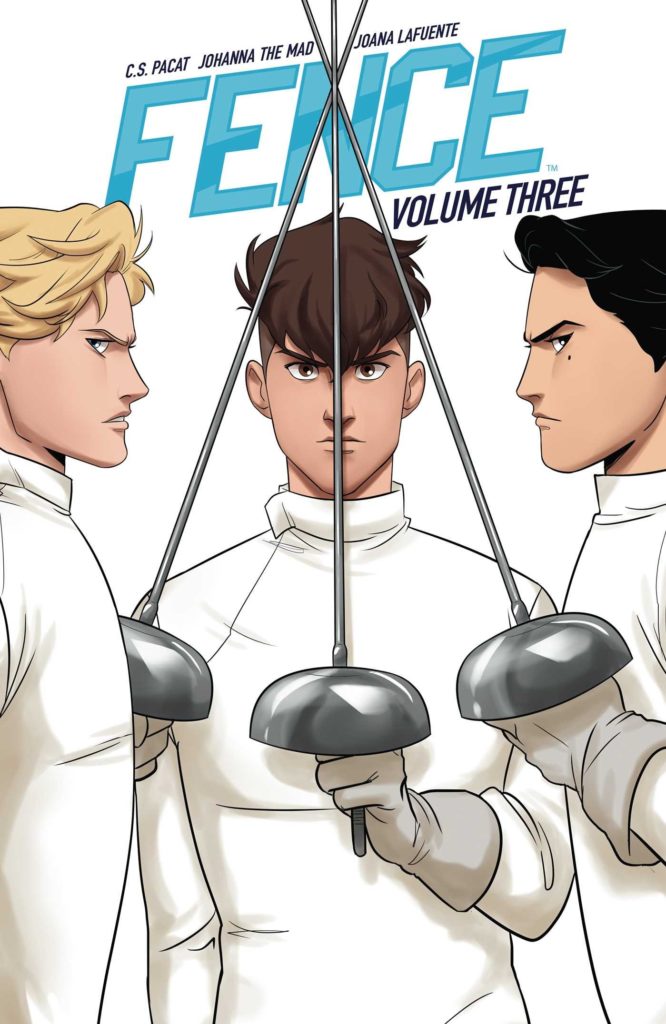
If the characters of your stories could interact with other characters from any fictional universe, which ones would they be and where would they be from?
SRB: I would like to see Nicholas learn from Westley in The Princess Bride, though Nicholas actually is left-handed! The skill of swordsmanship is such a big thing in the novel of The Princess Bride, even more so than in the book, because we can enter into people’s love and grief so strongly. Inigo Montoya learns the blade because he wants to avenge his beloved father. Our hero Westley learns because he wants to return alive to his beloved lady. It’s another classic example of love for a person, impelling you on to love for a skill. To prepare for writing the Fence novels, as well as reading fencing books and taking fencing lessons and talking to a fabulous fencing coach named Olga Velma, I watched a lot of the old Basil Rathbone movies with famous fencing scenes, and the duel on the Cliffs of Insanity remains a favorite for both skill and intensity of feeling. Maybe the Fence characters and the Princess Bride characters could all teach each other some moves.
CSP: The Ouran High School Host Club.
JM: Oh, I’d love a crossover with Slam Dunk. I think our Fence guys would look amazing in basketball uniforms. Plus, it’d be cute to see the interaction between Kings Row and the Shohoku team.
Are there any projects you are currently working on or project ideas you are currently nursing and are at liberty to speak about?
SRB: I’m always thinkin’. No idea how other people even make toast without considering battle scenes or tortured confessions or love. Currently playing around with ideas for a rom com in which rival actors fall in love, and horror in a town featuring evil bargains and drowned children… plus I very recently finished some more fun in the Fence universe.
CSP: My next project is a YA fantasy called Dark Rise that’s due out next year. It’s set in an alternate London, where the heroes and villains of a long-forgotten war are being reborn, ushering in a dangerous new age of magic. I had wanted to write a queer fantasy series with a vast world and epic stakes for a long time.
Finally, since this is an LGBTQ+ website, are there any LGBTQ+ authors and/or books you can recommend for our readers?
SRB: A recent fave for me is Leah Johnson’s YOU SHOULD SEE ME IN A CROWN. A fabulous heroine of color competes for the title of prom queen which will help her accomplish her academic goals… but she’s terribly distracted by the cute new girl in town. Zen Cho’s THE TRUE QUEEN has a really unique fantasy world as well as a slow burn, low key, but totally compelling wlw relationship at its heart, along with musings about the twists, turns, and bonds of sisterhood. For fans of swordsmanship and LGBTQ+ romance, a can’t-miss ur-text is Ellen Kushner’s SWORDSPOINT about the master swordsman and a boy of mystery, and the fabulous follow-up about the niece of the mad Duke who learns the blade, THE PRIVILEGE OF THE SWORD.
CSP: Fire From Heaven, by Mary Renault which tells the story of Alexander the Great and his love for Hephaestion. This one is a favourite, and Renault has been a huge influence on my own writing.
I just finished All Boys Aren’t Blue by LGBTQIA+ activist George M. Johnson, a memoir describing his experiences growing up Black and queer in America.
Barracuda, by Christos Tsiolkas—and I’d highly recommend the TV series of the same name. Tsiolkas and I share an ethnic background as Australian w*gs, and I really identify with the way the book and the TV series portrays the experience of being a queer w*g growing up in Australia in the 90s. Plus, it’s a sports story about boys at an elite private school!
Lastly, keep your eyes out for a book that’s coming out next year, She Who Became The Sun, by Shelley Parker-Chan. It’s a queer/genderqueer retelling of the rise of China’s first Emperor, and it is phenomenal.
Fence: Striking Distance is available September 29th

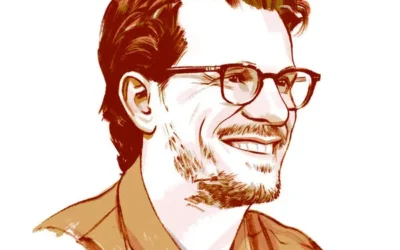

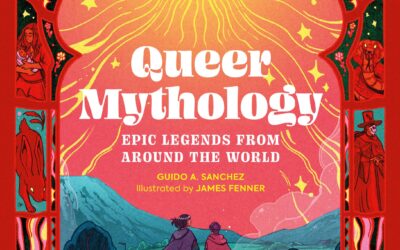


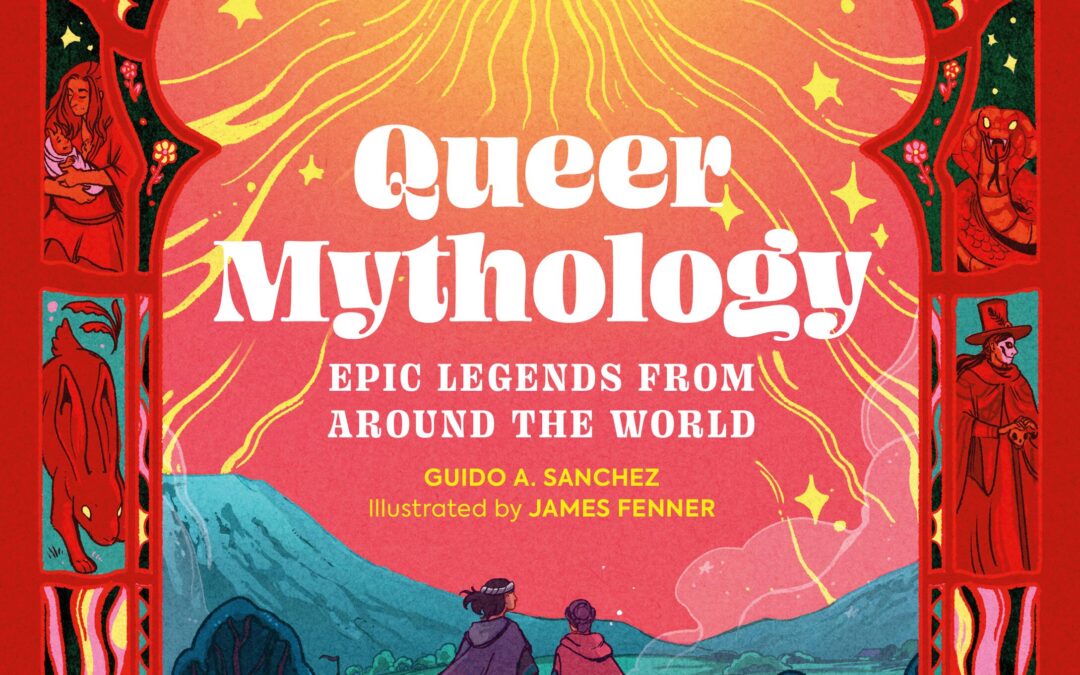
0 Comments